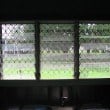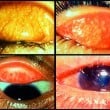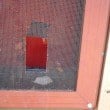B6.4 Insects: mosquitoes and flies
Mosquitoes and flies transmit disease including trachoma, which is carried by some types of flies and many mosquito-borne diseases. In Australia, examples of illnesses transmitted include Ross River Fever, Barmah Forest Disease, Dengue Fever and Murray Valley Encephalitis. Internationally, malaria is a major mosquito borne illness.
Houses and yards should be designed to reduce mosquito and fly breeding areas and areas of potential contact between mosquitoes, flies and people. Poorly graded or blocked roof gutters, rainwater tank inlets and overflow points, pooling water from dripping taps and/or poorly drained yard area could be breeding places for these insects.
Data shows that half of surveyed houses (50%) had some mosquito breeding areas and 17% of houses had flies or mosquitoes present at the time of survey.
One of the main strategies for reducing contact between flies, mosquitoes and people is screening doors and windows with insect mesh. Data shows that only 16% of surveyed houses had most (more than 80%) external openings fully screened.
Design and Specification
Ensure
- B6.4 .1.
in areas subject to mosquito borne disease, metal insect screening has been fitted to all doors and windows
- B6.4 .2.
the frames of screens are designed, specified and constructed to allow the mesh to be easily replaced, see information about fire escape requirements for screens at A3.3 ‘Escape in the event of fire’
- B6.4 .3.
rainwater tank inlets and overflows are screened
- B6.4 .4.
gully traps, vent pipes, septic tank soakage trench inlets, dry toilet vent pipes and other drains are screened
- B6.4 .5.
gutters are graded to fall towards the downpipe, can be easily cleaned and are designed to prevent damage by ladders during cleaning
- B6.4 .6.
sumps or pits are provided under all yard taps, downpipes, evaporative cooler and hot water system overflow, to prevent water ponding
- B6.4 .7.
the yard is graded to allow stormwater to drain away from the house and yard
- B6.4 .8.
outdoor food preparation areas can be hosed out and are connected to the waste water disposal system, to remove food scraps that could attract flies.
Consider
- offsetting lights away from doors and windows to deter insects from entering the house while ensuring that access is well lit
- using insect repellent light globes for external areas
- using woven stainless steel insect mesh
- providing outdoor power points and television antenna points to prevent residents piercing screens or leaving doors and windows ajar to connect power cords
- fencing the yard to keep out unwanted animals and reduce the amount of faeces in the yard that could attract flies
- selecting and placing plants to minimise mosquito breeding areas, and to deter flies and other insects.
Real world examples of Solutions
-
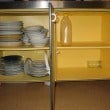 Gaps to joinery eliminated to prevent entry by flies
Gaps to joinery eliminated to prevent entry by flies -
 Yard is graded to drain stormwater and reduce pools of water that encourage mosquito breeding
Yard is graded to drain stormwater and reduce pools of water that encourage mosquito breeding -
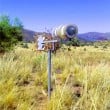 A fly trap designed to enable flies to be tested for the trachoma bacterium so action may be taken to reduce fly numbers
A fly trap designed to enable flies to be tested for the trachoma bacterium so action may be taken to reduce fly numbers -
 Camel dung was the main food of trachoma carrying flies and could be reduced by dung beetles
Camel dung was the main food of trachoma carrying flies and could be reduced by dung beetles
- B6.4 .1.
Quality control
- insect screens are fitted to all openings, are secure and intact, with no gaps between the screen and the window or door frame

- COMPLETED DESIGN & SPECIFICATION
AT HANDOVER
FINAL COMPLETION
TRADE TEST
- COMPLETED DESIGN & SPECIFICATION
- all sewer vents, gully traps, soakage trench inlets and vents, rainwater tank inlets and overflows, and dry toilet vent stacks have been fitted with an insect screen

- COMPLETED DESIGN & SPECIFICATION
AT HANDOVER
FINAL COMPLETION
- COMPLETED DESIGN & SPECIFICATION
- the yard has been graded to drain water away from the house and yard, and there are no flat spots beneath floor areas

- COMPLETED DESIGN & SPECIFICATION
AT HANDOVER
FINAL COMPLETION
- COMPLETED DESIGN & SPECIFICATION
- there are drainage sumps or pits under all yard taps, downpipes, evaporative cooler and the hot water system overflow

- COMPLETED DESIGN & SPECIFICATION
AT HANDOVER
FINAL COMPLETION
- COMPLETED DESIGN & SPECIFICATION
- planting layout has been carried out according to the specifications, if previously agreed.

- COMPLETED DESIGN & SPECIFICATION
DURING CONSTRUCTION
AT HANDOVER
FINAL COMPLETION
- COMPLETED DESIGN & SPECIFICATION
- insect screens are fitted to all openings, are secure and intact, with no gaps between the screen and the window or door frame
Maintenance
As part of cyclical maintenance:
- check for leaking waste water or taps and repair

- Local Maintenance Team
- 6 Months
- clean gutters

- Local Maintenance Team
- 12 Months
- trim plants and remove any plants that harbour water

- Local Maintenance Team
- 12 Months
- repair or replace any torn mesh on window and door screens

- Carpenter, Local Maintenance Team
- 6 Months
- repair or replace any torn mesh on sewer vents, gully traps, soakage trench inlets and vents, rainwater tank inlets and overflows, and check that dry toilet vent stack screens are intact.

- Plumber, Local Maintenance Team, Housing Management
- 6 Months
- check for leaking waste water or taps and repair
Standard And References
Apunipima Cape York Health Council, Centre for Appropriate Technology Inc., Healthabitat and Pormpuraaw Community Council 1997, Pormpuraaw Housing for Health, Towards a Healthy Living Environment for Cape York Communities, project report, p. 16
Bailey, C, Moran, M & Henderson, G 1995, A Response to the Encephalitis Outbreak on Badu Island in the Torres Strait in 1995: Improvements in Environmental Health, Queensland Health, Cairns
Queensland Government Department of Housing Policy and Standards, Document #13 ‘Security and Insect Screening Policy’

